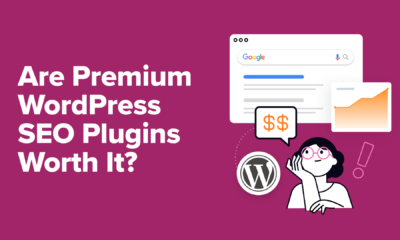SEO
Plugins, Tips & Proven Tactics

WordPress powers 39.5% of the world’s websites. As a leader in digital experiences, WordPress currently runs some of the most prominent websites like Sony, Microsoft, TechCrunch, and more.
Enterprise businesses require a scalable, credible, and reliable website to earn top domain authority and stay competitive.
While many organizations have turned to expensive solutions that often run up the budget and offer limited support, better options exist, like WordPress.
What started as a blogging platform ten years ago, WordPress is now the most popular content management system globally. With over 30 million enterprise WordPress websites live, the platform has grown to 65.2% CMS market share and continues to evolve year over year.
So, what makes WordPress suitable for enterprise businesses? There are many benefits – but at the top is how it can contribute to your SEO strategy to build trustworthiness and credibility in search results.
Let’s dig into all the top reasons WordPress is right for your enterprise and the tips you need to know to get started.
Is WordPress Good For Enterprises?
Since WordPress is open source software, your business has access to endless designers, developers, and specialized agencies, on top of a massive community that is all willing to collaborate and troubleshoot.
Advertisement
Continue Reading Below
With millions of WordPress websites live, the user community allows you to leverage best practices and implement them within your own system – instead of relying on inconsistent customer service or a limited FAQ page from closed-off systems.
Here are a few reasons why WordPress is great for enterprises:
- Ongoing support as opposed to proprietary systems that provide more flexibility and customization.
- Robust content editing experience with WordPress Gutenberg and accessibility standards.
- High-level security that keeps you protected against cyberattacks.
- Scalable infrastructure with consistent themes and plugins to help reach your goals.
- Huge costs savings by not having to pay hefty licensing costs compared to competitors like Adobe, Magento, and HubSpot.
WordPress is designed to stay and support enterprises.
Developers have downloaded over 81 million versions of WordPress. They have also created over 59,000 plugins and 9,000 themes. This is a testament to the core WordPress development team’s ability to improve the platform and meet modern business needs.
WordPress Benefits For Your Enterprise SEO Strategy
SEO is an essential part of your business’s digital strategy. To drive qualified website traffic, you need to ensure your content management system can handle the visibility and searchability you need to scale.
Advertisement
Continue Reading Below
Luckily for you, WordPress SEO is well-optimized to help you increase user engagement and boost rankings in SERPs.
Not only does it include several built-in features that help you better optimize your site, but there are several plugins to establish authority much easier.
Check out these nine WordPress SEO highlights:
- Permalinks: Customize your permalinks with targeted keywords to increase your CTR rate.
- Metadata: Automatically add title and meta description to every post or page on your website to improve your position.
- Images: Optimize your images by using keywords in the ALT text and improve your page speed by editing the size – not to mention 20% of all U.S. web searches happen on Google Images!
- User experience: Develop a well-designed site that enhances the user experience to increase pageviews, conversions, and session times.
- Site speed: Select the right themes and plugins that help you maintain a fast-loading time.
- Mobile-friendly: Use a mobile responsive theme to ensure it’s the same quality as the desktop version for a better user experience.
- Social media: Increase your brand visibility by including social media share and follow buttons on your website.
- Integration: Seamlessly integrate your WordPress site with other software like G Suite, Google Analytics, ConvertKit, and more.
When it comes to SEO, WordPress has all the tools you need to optimize your enterprise website with reliability and scalability.
Top 7 WordPress Plugins And Tools To Help You Become An SEO Rockstar
With 75% of people never going beyond the first Google search page, having an optimized site is an absolute must.
What’s the most significant way WordPress boosts your SEO rankings? Plugins.
WordPress plugins and tools optimize your site to boost SEO efforts and improve site security, performance, and speed.
But, with so many different plugins and tools in the market today – how do you choose the right ones that will improve your site’s visibility?
To help you avoid a SEO disaster, let’s take a look at the top WordPress tools and plugins for search optimization.
1. All in One SEO (AIOSEO)
Made popular by over two million users, AIOSEO offers a comprehensive toolkit and setup wizard for you to establish SEO settings for your website quickly. The checklist includes features like meta tag generators, titles, descriptions, rich snippet schema markup, and XML sitemaps.
For tech-savvy users, AIOSEO gives you complete control of Robosts.txt, local SEO, RSS videos, video and photo optimizations. It also allows enterprises to assign user roles to employees or contractors.
2. BrightEdge
BrightEdge provides AI-powered data-driven solutions to help you manage your SEO and content performance to convert more users into customers.
You can leverage BrightEdge throughout every stage of content optimization: discovering your target audience’s search demand, creating impactful content, and measuring results to scale.
Advertisement
Continue Reading Below
With powerful data insights like share of voice, opportunity forecasting, and ContentIQ your content is more likely to capture your audience’s attention and boost SEO efforts.
3. Semrush
As one of the best SEO tools in the market, Semrush allows you to find all the organic keywords and search terms that your website can rank. It also provides a competitive analysis of how your competitors rank, so you know how to gain an edge over their SEO strategy.
With Semrush’s Writing Assistant Tool, you can also improve your existing WordPress content with targeted focus keywords to help you make the top 10 results.
4. Yoast SEO
Yoast SEO lets you easily update descriptions, titles, and social media images throughout your website. With a user-friendly platform, Yoast SEO automatically creates an XML sitemap to make it easier for search engines to crawl your website and import data from other plugins.
You also have complete control of your site breadcrumbs and premium loading times.
Advertisement
Continue Reading Below
5. Ahrefs
Ahrefs is an all-in-one SEO tool that helps optimize your website, analyze industry content, and study your customer’s top keywords to help you improve.
With Ahrefs, you can track your ranking progress and learn from your competitor’s content to deliver a high-ranking website that builds authority.
Additionally, Ahrefs provides enterprise-level support with unique features like multiple user seats, personalized customer support, daily updates, and more to help your business grow globally.
6. NitroPack
With over one million websites using NitroPack, it’s safe to say that performance plugins can positively impact your SEO presence. NitroPack helps increase your Speed Score by 69% and improves your Core Web Vitals you can provide a better experience to users.
It provides advanced features like caching, built-in CDN, and HTML optimization in a user-friendly platform.
7. MonsterInsights
Instead of relying on SEO assumptions, MonsterInsights provides you with all the insights you need to improve search rankings by connecting Google Analytics to your WordPress site.
Advertisement
Continue Reading Below
MonsterInsights shows you top content, how users interact on your site, and connects ecommerce SEO.
Also, MonsterInsights provides over 100 data points to help you make better marketing decisions through real-time analytics.
More Tried And True WordPress SEO Best Practices For Enterprises
With 40 to 60 billion estimated Google searches in the U.S each month, your enterprise needs to focus on an on-page and off-page SEO strategy.
 Image created by author, December 2021
Image created by author, December 2021On-page SEO includes creating valuable content, adding targeted keywords, and having metadata on every website page or post.
Advertisement
Continue Reading Below
On the other hand, off-page SEO involves building links on third-party websites to improve your site’s trustworthiness, relevance, and authority.
To help you get started, here are a few additional on and off-page SEO best practices for your WordPress site:
- Use a dedicated focus keyword for each page and include it in key places like your titles, first paragraph, and the URL.
- Write valuable and authentic content that not only delights your users but signals to search engines that you’re a credible enterprise.
- Choose a theme that supports SEO best practices, like headings or title tags, and offers your users a simple customer experience.
- Select a plugin that develops an automatic Google XML sitemap to help search bots easily crawl your website.
- Start building backlinks with other high-ranking websites through content partnerships, guest blogging, and directory profiles.
- Protect your site against third-party attacks by using SSL and HTTPS for enhanced WordPress enterprise security.
- Take advantage of local SEO features by creating a Google My Business and using localized keywords in your content.
Now, search engines keep getting more intelligent, and for enterprises to improve rankings, you need to keep up.
Using the right plugins is a great start, but staying on top of the algorithms, monitoring your traffic daily, and implementing SEO best practices will help ensure you drive users back to your website.
Scale Your WordPress Enterprise Website With SEO
Is WordPress enterprise-ready?
Combined with powerful plugins and themes, WordPress’s content management system is more than ready to handle the needs of a complex enterprise website. With WordPress, you can scale your website with flexible infrastructure and reliable SEO features.
Advertisement
Continue Reading Below
WordPress is one of the best platforms for SEO. Not only does the system provide SEO features, but the plugins available make it easy for your website to start building authority and boost your overall rankings.
With a higher ranking, you’re more likely to drive the right traffic back to your site that converts into future customers.
More resources:
Featured Image: RoBird/Shutterstock













![How to Create A Website to Sell Products In 8 Steps [+6 Expert Tips] How to Create A Website to Sell Products In 8 Steps [+6 Expert Tips]](https://articles.entireweb.com/wp-content/uploads/2024/10/1727868370_How-to-Create-A-Website-to-Sell-Products-In-8.webp-400x240.webp)
![How to Create A Website to Sell Products In 8 Steps [+6 Expert Tips] How to Create A Website to Sell Products In 8 Steps [+6 Expert Tips]](https://articles.entireweb.com/wp-content/uploads/2024/10/1727868370_How-to-Create-A-Website-to-Sell-Products-In-8.webp-80x80.webp)




You must be logged in to post a comment Login